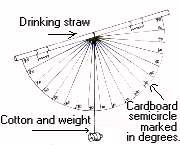![]()

Leonardo loved nature in all its forms; he sketched flowers, gathered leaves and took endless notes. He understood that you could find the age of a tree by counting the growth rings, and that the width of each ring related to the weather conditions of that growth year. Students will also try to determine the age and growth conditions of a tree by looking at sawn cross sections of trees.
He liked to test his own perception by guessing at heights of objects and their distance away. This was excellent practice for proportion and mapmaking. Leonardo would test his estimates by pacing the distance and by measuring shadows. Students will learn how to make accurate estimates of object heights, using trees and buildings as examples. They will build a clinometer (see image below) to help their estimates using degrees and angles, which will in turn aid in the Sky Science unit estimating the position of the moon and planets.
As a class, the students will try to determine if there is any relationship between a trees age and height using the techniques listed above. This will introduce various tree species, life span, growth rate and conditions each requires.
